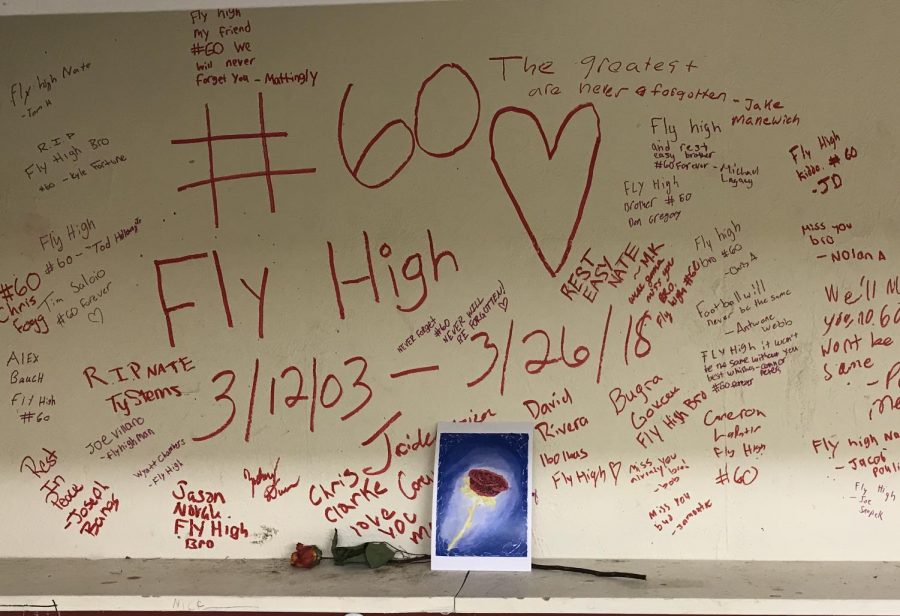Increase of suicide awareness at LHS
April 11, 2018
Staff and students at Ludlow High School are left devastated after the sudden loss of 15-year-old Nathan Carreira on March 26, with teachers reading a prepared statement to their students that read in part, “there has been some talk about the possibility that this was a suicide death.”
I spoke to LHS school adjustment counselor Jacqueline Dupont about what is causing more young people to turn to suicide as the only option and how we as a society can prevent future deaths.
“Think about how much things have changed even since you were a child. The world is so different, families are different, how we cope with stress is different,” she said.
Specifically, Dupont says that schools are becoming more challenging.
Stressful environments can cause suicide, she said. Stress due to school, more instances of online bullying, and kids having unrestricted access to the internet via smartphones can be tough for young people to deal with.
“This stuff happens and we know that kids as young as 9 and 10 have killed themselves over peer interactions, and one due to a snapchat hoax,” she says. ¨I think children are growing up with access to a lot more than they should, and their brains are not equipped to deal with and disseminate all of it. A lot of teenagers can’t either.”
According to Dupont, the prefrontal cortex of the brain, which controls impulse and motivation, and is the “logical” part of the brain, is “not fully developed and functioning until you’re about 22 to 25 [years old].” This would imply that young teenagers are not capable of making the best decisions.
With the changing social media environment and the fact that people have access to any information they want via the Internet, kids are more at risk than ever. Not only can they be negatively affected by social media, they also have the means to acquire the knowledge of how to hurt themselves if they are experiencing significant stress, anxiety, or depression.
“Now there are kids that are pretty young, with their faces stuck in a phone, tablet, etcetera, missing out on interactions and texting and picking up on a lot of mis-cueing. We say things to people over social media that we would never say to their faces,” says Dupont, adding that children “are not equipped to deal with these things.”
Students with learning disabilities are particularly at risk, Dupont says. For example, say a 10-year-old student has a specific learning disability, and he is already struggling to catch up with his peers in the classroom, and because of that he may believe that no one else likes him, or that he’s not smart. Now, take that student and add a lack of “impulse control” (which can be a typical kid thing), and you have a child that may really struggle with peer acceptance. “Maybe a kid or two has said something about you and called you annoying,” or it was done indirectly via Snapchat — this can lead to an irrational reaction.
Another big factor must be considered: the possibility of mental illness. “If [they] or an immediate family member has a diagnosed mental health issue” it can exacerbate the situation.
Mental illness can be tough to predict and treat. It’s best left to the professionals. However, there are things we as a community can do to try and prevent future deaths.
Children’s mental health and how the environments can affect mental health can be taught at the middle and high school levels. Parents, students, and teachers should all be educated on mental health.
“The only way to combat it, in my opinion, is to have an ongoing dialogue about what are normal feelings among adolescents and teens and what is moving into an area of concern,” says Dupont. “What is normal for teens is not normal for children.”
Staff here at LHS are all trained in childhood development and know what is normal for children and what isn’t. Dupont adds that we have different specialists in the district and need to utilize them.
“I think overall each community needs to reach out and work with other districts and support one another and see what ideas the others have because it is turning into a bigger issue than just a couple young people here and there,” she says.
Teachers at LHS were provided information from the administration that included the following “What to do” guidelines when dealing with a potential suicide threat:
- Remain calm.
- Ask the youth if he or she is thinking about suicide.
- Avoid being accusatory and do not judge.
- Listen and reassure that help is available.
- Supervise the individual and remove any means of self-harm.
- And most importantly, get help. Anyone who knows of anybody who may be thinking about suicide should tell an adult.
We may never know the answers as to why Nate Carreira chose to take the drastic action that he did, however we can try to combat this and try to decrease the risks. Be nice to one another, help and support each other.


